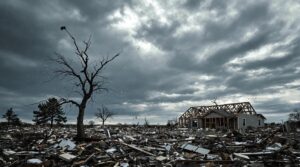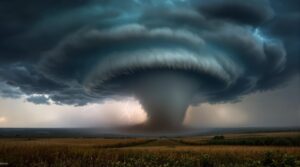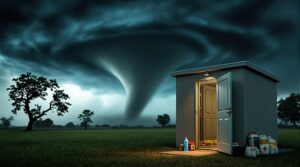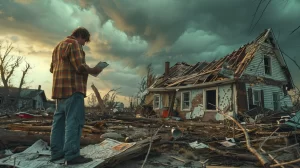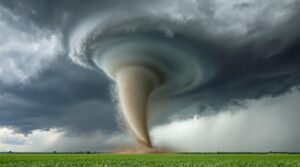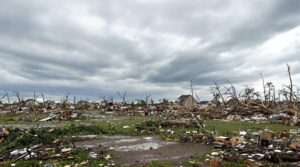Standard homeowners insurance policies typically cover tornado damage through windstorm provisions. Coverage includes structural damage to the home, personal belongings, and additional living expenses if temporary relocation becomes necessary. However, flood damage from tornado-related rainfall requires separate flood insurance. Homeowners in high-risk areas face unique considerations regarding coverage limits and specialized deductibles. Understanding the specific details of policy coverage reveals essential protection strategies for tornado-prone regions.
Key Takeaways
- Standard homeowners insurance typically covers tornado damage through windstorm provisions, including damage to the home's structure and personal belongings.
- Policies cover wind damage to roofs, windows, siding, and other structural elements under Coverage A – Dwelling Protection.
- Additional living expenses are covered if tornado damage makes your home temporarily uninhabitable.
- Flood damage from tornado-related rainfall requires separate flood insurance, as it's excluded from standard policies.
- Insurance coverage in tornado-prone areas may include specific wind/hail deductibles and higher premiums based on geographic location.
Understanding Basic Tornado Coverage in Home Insurance
While most standard homeowners insurance policies include coverage for tornado damage, understanding the specific components and limitations of this coverage is essential for adequate protection. Standard policies typically cover windstorm and hail damage, though separate deductibles may apply in high-risk areas.
Insurance policy comparisons reveal that coverage varies by policy type, with HO-1, HO-2, and HO-3 policies offering different levels of protection against tornado-related perils. The basic coverage framework includes protection for the dwelling structure, personal belongings, and temporary living expenses if the home becomes uninhabitable. However, flood damage, which often accompanies tornadoes, requires separate insurance coverage.
As part of tornado preparedness measures, homeowners should review their policies regularly to understand exclusions and limitations. Geographic location greatly influences coverage costs and availability, with properties in high-risk tornado zones typically commanding higher premiums.
Understanding these fundamentals enables homeowners to make informed decisions about their insurance needs. Comprehensive liability coverage protection helps safeguard against potential lawsuits from tornado-related injuries or property damage to others.
Types of Damage Covered by Standard Policies
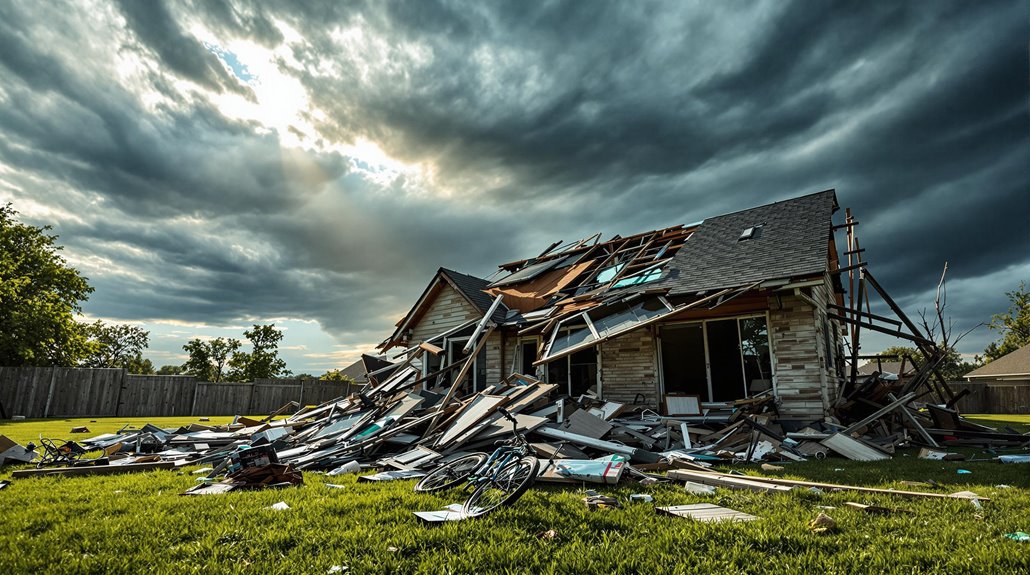
Standard homeowners insurance policies provide extensive coverage for tornado-related damage through multiple protection categories.
Structural wind protection covers repairs to the home and attached structures, while contents coverage reimburses for damaged personal belongings based on either actual cash value or replacement cost.
Additional living expenses coverage assists with temporary housing costs and related expenditures when a tornado renders a home uninhabitable.
For maximum protection, homeowners should consider adding umbrella coverage to extend liability limits beyond standard policy coverage.
Structural Wind Protection
Most homeowners insurance policies provide extensive coverage for tornado-related wind damage to a property's structure through their dwelling coverage component.
This protection, often referred to as Coverage A, specifically addresses damage to core structural elements, including the roof, siding, and windows caused by powerful tornado winds.
In regions prone to severe weather events, windstorm preparedness becomes particularly significant as policies may include special considerations or deductibles.
While standard coverage typically encompasses wind-related structural damage, certain exclusions apply, especially in high-risk areas.
Insurance providers emphasize tornado safety by covering primary wind damage, though they exclude flood damage from accompanying storms.
Property owners should note that Coverage A has specific limits and deductibles, making it essential to understand policy details for adequate structural protection against tornado events.
Homeowners can often customize their policies to ensure comprehensive protection against specific regional weather risks and structural vulnerabilities.
Contents and Belongings Coverage
Personal belongings damaged by tornadoes fall under the contents coverage component of homeowners insurance policies, specifically through named peril protection.
Standard policies typically cover furniture, electronics, clothing, and other personal items damaged by windstorms or flying debris, subject to policy limits and deductibles.
Coverage can be based on either replacement cost or actual cash value, depending on the policy terms.
While HO-3 policies offer the most extensive protection, homeowners should maintain a detailed contents inventory to facilitate claims and identify potential coverage gaps.
Some high-value items may require additional coverage beyond standard policy limits.
It is essential to recognize that damage from flooding, even during a tornado, is excluded from standard coverage, as are losses resulting from poor maintenance or negligence.
Personal property coverage typically amounts to 50% of your dwelling coverage limit when calculating adequate protection for your belongings.
Additional Living Costs
When tornadoes render homes uninhabitable, Additional Living Expenses (ALE) coverage provides essential financial protection for temporary displacement costs. This coverage, also known as loss of use coverage, typically reimburses homeowners for emergency housing and other temporary costs until their residence is repaired or rebuilt. Unlike other policy components, ALE coverage generally does not require a deductible payment. For comprehensive protection, homeowners should review their liability coverage limits alongside ALE coverage to ensure adequate financial security.
| Expense Type | Coverage Details | Duration |
|---|---|---|
| Hotel/Lodging | Reasonable costs for temporary accommodation | Until home is habitable |
| Meals | Restaurant expenses above normal food costs | Throughout displacement |
| Transportation | Additional mileage or transit costs | During temporary relocation |
| Storage | Fees for protecting undamaged belongings | While repairs ongoing |
| Utilities | Additional costs at temporary residence | During displacement period |
Essential Coverage Components for Tornado Protection
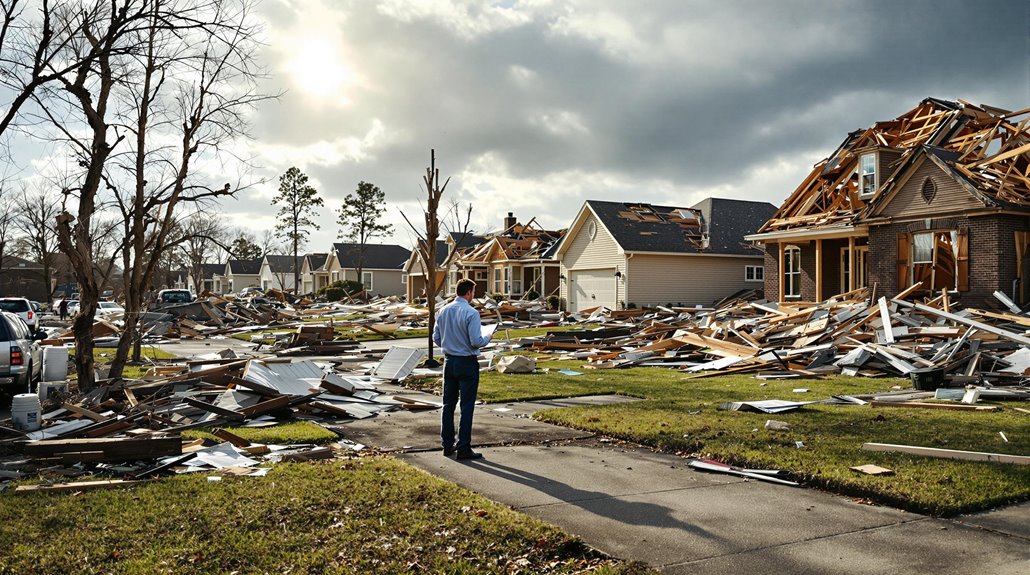
The essential coverage components for tornado protection in a home insurance policy consist of three primary elements: dwelling coverage, personal property coverage, and additional living expenses coverage.
Dwelling coverage protects the structure of the home and attached features like decks and garages from tornado damage, though separate windstorm deductibles may apply in high-risk areas. As part of tornado preparedness tips, homeowners should understand that this coverage excludes flood damage from accompanying storms.
Personal property coverage safeguards belongings inside the home, operating on a named peril basis with specific policy limits. This component may offer either actual cash value or replacement cost coverage.
Additional living expenses coverage provides funds for temporary housing and related costs when tornado damage renders a home uninhabitable. This coverage, typically included in standard policies, helps maintain the household's lifestyle during emergency response planning and reconstruction, usually without requiring a deductible.
Common Exclusions and Limitations to Watch For
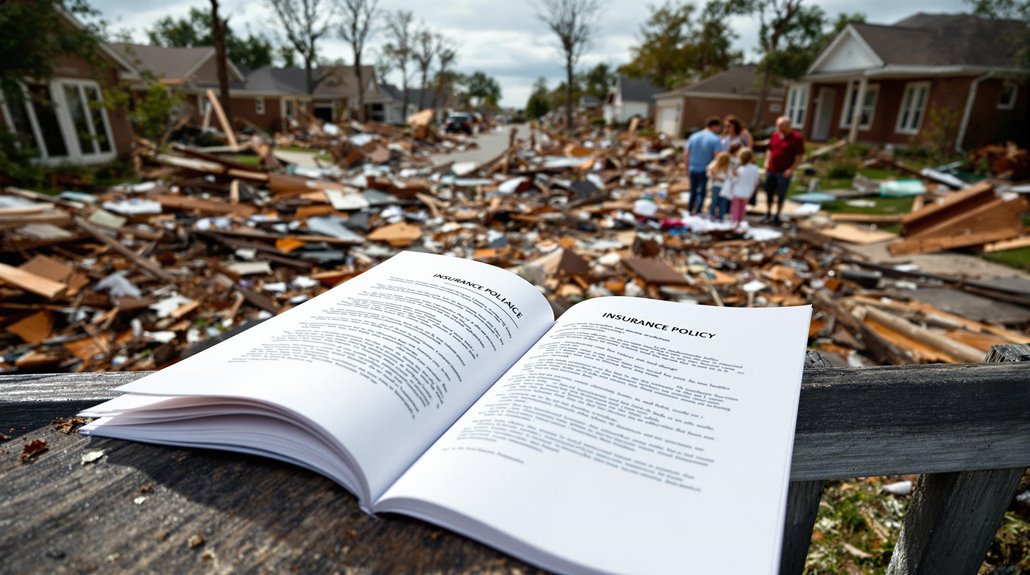
Understanding tornado coverage requires careful attention to several vital exclusions in standard homeowners insurance policies. Among the most significant exclusion examples are flood-related damages, including flash floods that accompany tornadoes, which require separate flood insurance coverage.
Policy limitations extend to maintenance-related issues, where damage resulting from pre-existing property neglect may be denied. For instance, trees that fall due to rot rather than storm force might not qualify for coverage.
Additionally, specific policy exclusions may encompass windstorm damage, and earthquake damage typically requires separate coverage entirely.
Insurance policies often impose distinct wind and hail deductibles, particularly in high-risk regions.
Coverage limits determine maximum payment amounts for covered losses, while the type of coverage-actual cash value versus replacement cost-affects reimbursement levels.
Understanding these limitations is essential, as they directly impact the policyholder's financial responsibility during tornado-related claims.
Special Considerations for High-Risk Areas
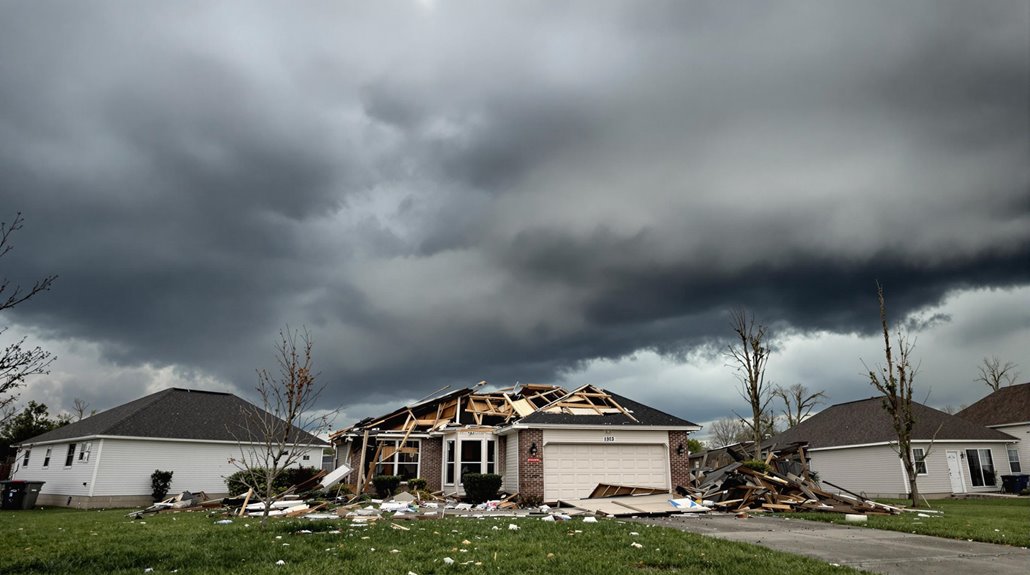
Residents living in high-risk tornado regions face unique insurance challenges that demand specialized coverage considerations. States within Tornado Alley, including Texas, Louisiana, and Oklahoma, typically require homeowners to maintain higher coverage limits due to increased natural disaster risks.
Home location greatly impacts insurance premiums and policy requirements. Standard homeowners insurance policies generally cover tornado damage through their windstorm provisions, but specific regional considerations may apply. Properties in high-risk areas often face separate windstorm deductibles and potential coverage exclusions.
While dwelling coverage protects the home's structure, and personal property coverage safeguards belongings, certain policies may exclude wind damage entirely, necessitating separate windstorm insurance.
Additionally, homeowners must recognize that flood damage from tornado-related rainfall requires separate flood insurance, as this is not covered under standard policies.
Understanding these nuances is essential for maintaining adequate protection in tornado-prone regions.
Filing a Tornado Insurance Claim
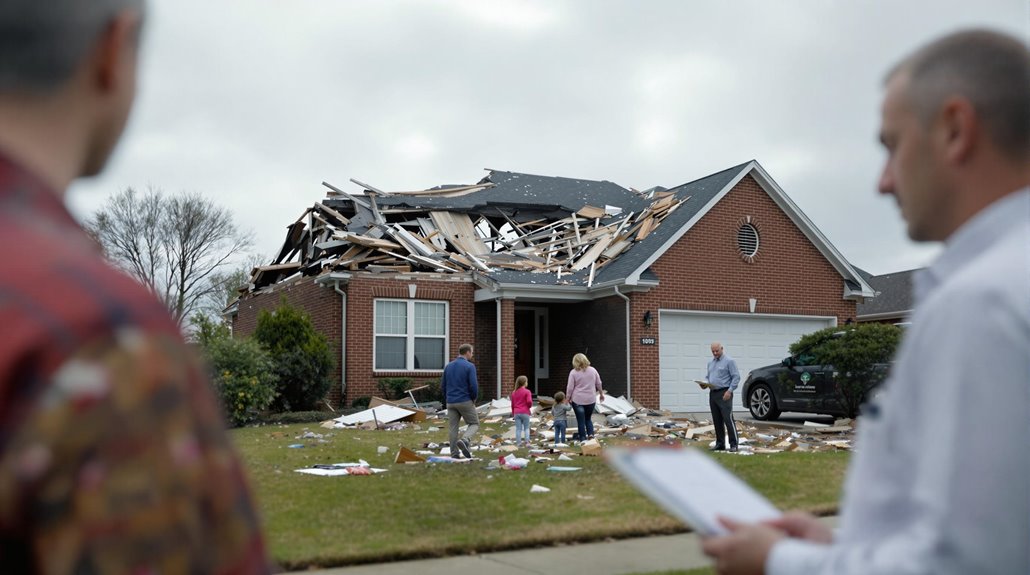
After securing appropriate coverage for tornado-prone areas, homeowners must follow specific procedures when filing an insurance claim for tornado damage. The process begins with immediate notification to the insurance provider, accompanied by thorough tornado damage assessment documentation, including photographs, videos, and detailed written records of all affected property.
Essential claim filing tips include maintaining extensive documentation of all communications with insurance representatives, submitting claim forms promptly, and adhering to specified deadlines throughout the process. Homeowners should prepare detailed inventories of damaged items and retain all relevant correspondence.
Regular follow-up with adjusters ensures proper claim progression and helps address any potential issues promptly. The claims process requires careful attention to policy requirements, state regulations, and dispute resolution procedures.
When necessary, homeowners should be prepared to engage legal professionals if complications arise during the claims process, particularly in cases involving significant damage or claim disputes.
Additional Insurance Options to Consider
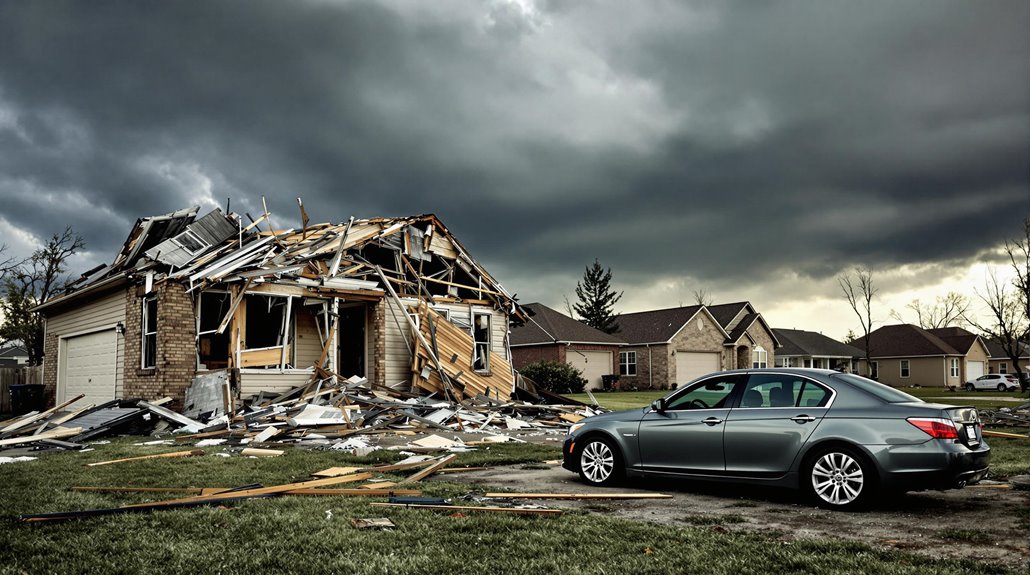
While standard homeowners insurance covers most tornado damage, property owners should consider supplemental flood insurance through the National Flood Insurance Program to protect against water damage that standard policies exclude.
A personal umbrella policy provides additional liability coverage beyond standard policy limits and can offer extra protection for severe tornado events.
Business owners require separate commercial property coverage to protect business assets and inventory from tornado damage, as these items are not covered under residential policies.
Flood Insurance Essentials
Most homeowners are unaware that standard home insurance policies exclude flood damage, making flood insurance a critical consideration for protecting property investments.
With flooding ranked as the nation's primary natural disaster and just one inch of floodwater capable of causing $25,000 in damage, flood insurance importance cannot be overstated.
NFIP policies overview reveals coverage limits of $250,000 for residential structures and $100,000 for personal belongings.
These policies are available in nearly 23,000 participating communities, with mandatory requirements for properties in high-risk areas with government-backed mortgages.
Coverage excludes damage from broken pipes, plumbing overflows, or rain entering through walls and roofs.
A 30-day waiting period applies unless required by federally backed lenders or related to community flood map changes.
Personal Umbrella Policy Protection
For thorough protection beyond standard insurance limits, personal umbrella policies provide an additional layer of liability coverage that safeguards against catastrophic losses. These policies typically offer coverage in $1 million increments up to $5 million, activating after underlying policy limits are exhausted.
| Coverage Type | Required Minimum | Umbrella Policy Benefits |
|---|---|---|
| Auto Liability | $250,000/$500,000 | Extended Protection |
| Home Liability | $300,000 | Legal Defense Coverage |
| Watercraft | Similar Limits | Asset Protection |
| Recreation Vehicles | Similar Limits | Additional Security |
The liability protection extends to all household members, making umbrella policies valuable for homeowners, renters, and individuals with increased risk factors such as pools or recreational vehicles. Policy eligibility typically requires good driving records and maintaining minimum liability coverage on underlying policies.
Business Property Coverage
As businesses face increasing risks from severe weather events, extensive property coverage becomes essential for protecting physical assets and guaranteeing operational continuity. A thorough business property insurance policy specifically addresses tornado preparation by safeguarding buildings, equipment, inventory, and furnishings against structural damage and content loss.
Beyond standard property coverage, businesses should consider business interruption insurance to maintain financial stability during temporary closures and repairs. This coverage compensates for lost revenue and ongoing operating expenses.
Liability insurance provides additional protection against potential lawsuits resulting from tornado-related injuries or property damage. For complete protection, businesses may need supplemental endorsements and separate flood insurance policies.
Regular evaluation of coverage limits guarantees adequate protection of business assets and helps identify potential gaps in coverage.
Steps to Evaluate Your Current Coverage

Understanding your home insurance coverage against tornado damage requires systematic evaluation of multiple policy components. A thorough policy review should examine the four main coverage types: dwelling coverage (Coverage A), other structures coverage (Coverage B), personal property coverage (Coverage C), and additional living expenses coverage (Coverage D).
Homeowners must verify that their policy includes standard wind damage protection and understand any specific windstorm deductibles that may apply in high-risk areas.
Identifying coverage gaps involves examining policy exclusions, particularly those related to flooding and maintenance-related damage. Special attention should be given to policy limits and whether they provide adequate protection for full reconstruction costs.
For extensive protection, evaluation should extend to determining whether supplemental coverage is necessary, such as separate windstorm policies or flood insurance through the National Flood Insurance Program.
Consultation with an insurance agent can provide clarity on specific coverage details and recommendations for additional protection.
The Benefits Of Consulting A Public Adjuster
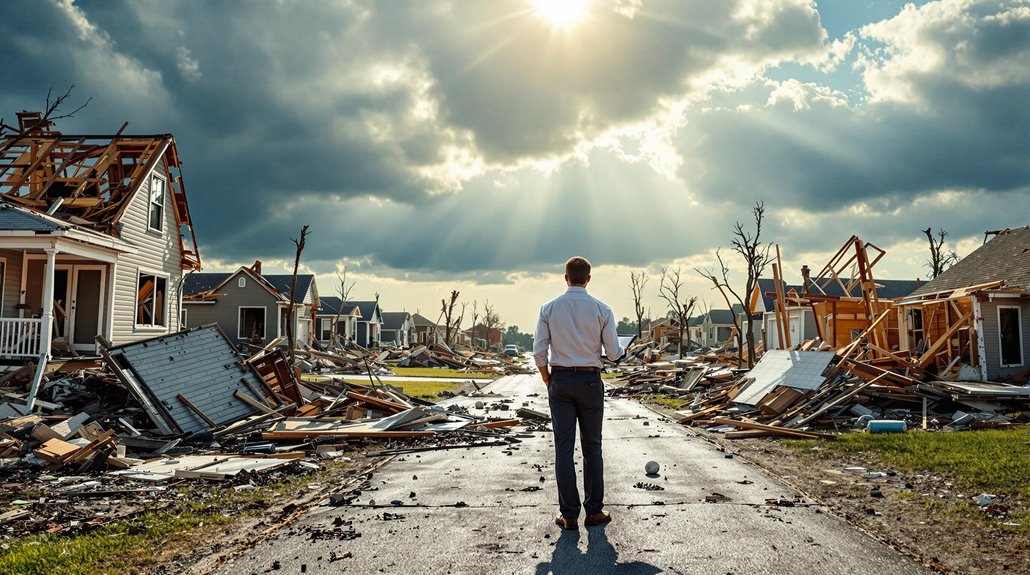
Public adjusters bring specialized knowledge in insurance claims processing and provide unbiased damage assessments following tornado events.
Their expertise helps streamline the complex claims process by managing documentation, communications, and negotiations with insurance providers.
Studies indicate that policyholders who engage public adjusters often receive higher claim settlements due to thorough damage evaluation and skilled negotiation practices.
Expertise In Insurance Claims
When guiding through the complex aftermath of tornado damage, consulting a public adjuster offers property owners significant advantages in managing insurance claims.
These professionals possess extensive knowledge of insurance policies, understanding intricate coverage terms and procedural requirements essential for successful claim disputes. Their expertise extends to identifying policy exclusions and determining when additional coverage may be necessary.
Public adjusters excel in policy negotiations through their thorough documentation practices and detailed understanding of insurance company procedures.
They systematically compile proof of loss documentation, damage assessments, and repair estimates while maintaining emotional detachment during negotiations. Working on a contingency basis, typically charging 5-15% of the settlement, these licensed professionals leverage their expertise to maximize claim settlements while ensuring compliance with state insurance regulations.
Objective Damage Assessment
A thorough objective damage assessment forms the cornerstone of successful insurance claims following tornado damage. Public adjusters conduct extensive evaluations that identify both visible and concealed structural damage, making certain no aspect of the loss goes undocumented.
Their tornado damage assessment protocols encompass detailed documentation and professional analysis of all affected areas.
These independent professionals employ systematic recovery strategies to maximize claim settlements by leveraging their expertise in property damage evaluation.
Unlike insurance company adjusters, public adjusters work solely for the policyholder's interests, providing unbiased assessments that often reveal damages overlooked during initial inspections.
Their specialized knowledge enables them to identify areas requiring expert evaluation, particularly in complex scenarios where multiple types of damage may be present.
This methodical approach helps make certain policyholders receive fair compensation for their losses.
Streamlined Claim Process
The streamlined process of consulting a public adjuster offers numerous advantages for homeowners facing tornado damage claims. Public adjusters serve as expert representatives who manage the entire claim process, from initial documentation to final settlement negotiations.
| Claim Process Advantages | Public Adjuster Roles |
|---|---|
| Single point of contact | Expert representation |
| Efficient communication | Documentation management |
| Objective assessment | Negotiation with insurers |
| Maximized settlements | Regulatory compliance |
| Reduced policyholder stress | Complex claim coordination |
Public adjusters work on a contingency basis, aligning their interests with the policyholder's goals. Their professional experience and knowledge of local insurance laws guarantee thorough claim reviews and accurate damage assessments. By handling all aspects of the claim process, public adjusters minimize policyholder stress while maximizing potential settlements through meticulous documentation and skilled negotiation strategies.
Higher Claim Payouts & Settlements
Statistical evidence strongly supports the financial benefits of engaging public adjusters for tornado damage claims. Research by the Florida Association of Public Insurance Adjusters demonstrates that claims handled by public adjusters yield considerably higher settlements, averaging $22,266 compared to $18,659 without professional representation.
Public adjusters enhance claim evaluation through their expertise in thorough damage assessment, often identifying losses that homeowners might overlook. Their extensive understanding of insurance policies enables them to interpret coverage terms effectively, ensuring policyholders receive maximum entitled benefits.
During settlement negotiation, these professionals leverage their industry knowledge to counter insurance company tactics that could minimize payouts. Working on a contingency basis, public adjusters are incentivized to secure ideal settlements while handling all paperwork and communications, allowing homeowners to focus on recovery.
About The Public Claims Adjusters Network (PCAN)
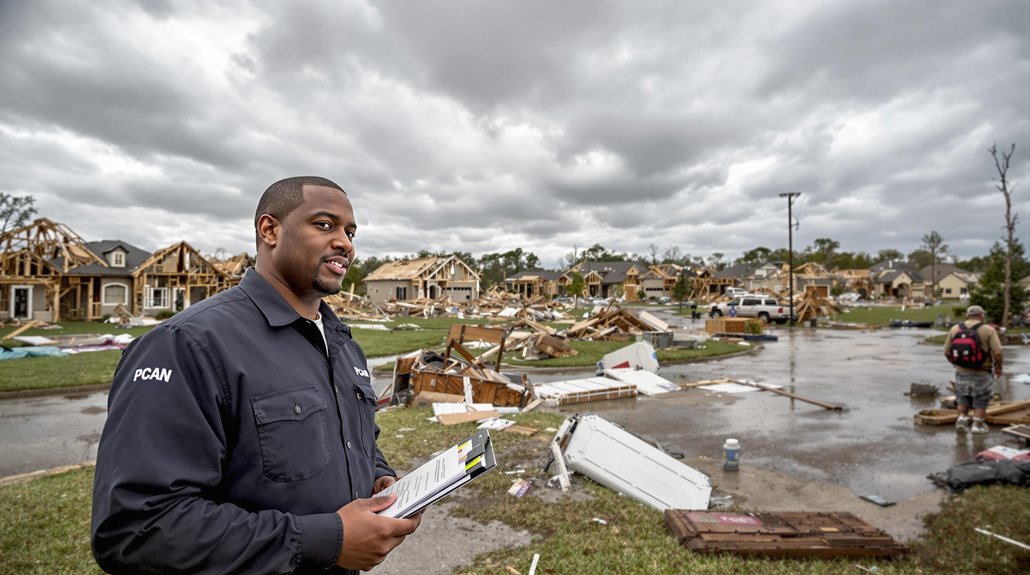
Professional advocacy stands at the core of the Public Claims Adjusters Network (PCAN), an organization dedicated to providing independent insurance claim representation for property owners affected by tornado damage and other catastrophic events.
As licensed professionals, PCAN's public adjuster roles encompass thorough damage evaluation, policy interpretation, and expert claims advocacy throughout the settlement process.
PCAN operates with a systematic approach, offering specialized knowledge in high-risk areas and immediate assistance during catastrophic events. Their adjusters validate claim legality, create customized plans based on specific policies, and handle all communication with insurers, contractors, and witnesses.
The organization's expertise extends to calculating business interruption costs and evaluating long-term property value impacts.
Through their global operations and proven expertise, PCAN delivers tailored solutions that address unique challenges while ensuring clients receive fair compensation through professional representation and efficient claims handling procedures.
Frequently Asked Questions
Does Home Insurance Cover Damage to Fences and Detached Structures From Tornadoes?
Standard homeowners insurance policies cover tornado damage to fences, detached garages, and other standalone structures through Coverage B, typically allocating a percentage of the dwelling coverage for fence repair and structural restoration.
How Long Does Temporary Housing Coverage Last After Tornado Damage?
Like a clock ticking toward completion, temporary housing duration typically extends until home repairs finish, though coverage limits vary by policy, generally lasting several months to a year.
Will Insurance Rates Increase After Filing a Tornado Damage Claim?
Insurance rates following tornado damage claims may increase during premium adjustments, though individual claim impact varies based on claim history, regional risk factors, and overall insurance claim process outcomes.
Are Trampolines and Outdoor Equipment Covered During Tornado Damage?
Standard homeowners insurance typically includes trampoline coverage and outdoor equipment damage from tornadoes, provided safety requirements are met and specific policy conditions, including deductibles and coverage limits, are satisfied.
Does Homeowners Insurance Cover Damage From Tornado-Launched Debris From Neighboring Properties?
Homeowners insurance typically covers damage from tornado-launched debris originating from neighboring properties. The neighbor's liability coverage would be primarily responsible for repairing damage caused by their property's debris.
References
- https://www.nerdwallet.com/article/insurance/does-homeowners-insurance-cover-tornado-damage
- https://www.insuranceclaimrecoverysupport.com/does-homeowners-insurance-cover-a-tornado/
- https://www.allstate.com/resources/home-insurance/insurance-for-tornado-damage
- https://carrigananderson.com/faqs/does-homeowners-insurance-cover-tornado-damage/
- https://www.bankrate.com/insurance/homeowners-insurance/tornado-insurance/
- https://www.fbitn.com/blog/insurance-101/home-insurance-tornado-damage
- https://www.wallaceinsurancelaw.com/does-homeowners-insurance-cover-tornado-damage/
- https://www.thv11.com/article/news/verify/extreme-weather-verify/do-homeowners-insurance-policies-cover-tornado-wind-damage/536-acf73283-009a-4a65-9ed5-779a518b2017
- https://unitedwaterrestoration.com/blog/tornado-damage-and-homeowners-insurance-is-it-covered/
- https://www.insuranceclaimrecoverysupport.com/does-homeowners-insurance-cover-hurricane-damage/
